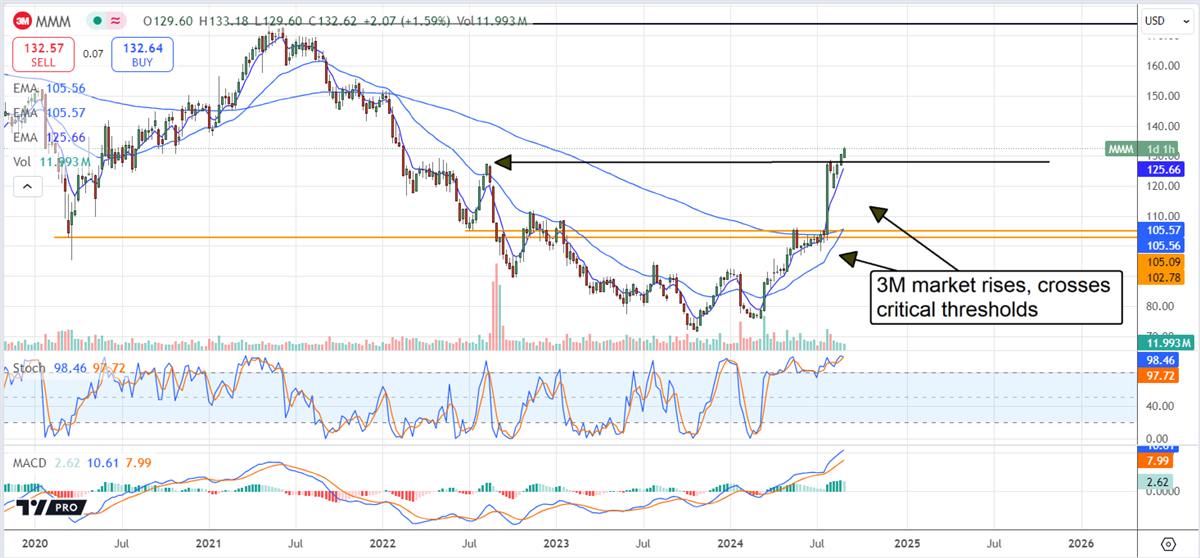Ticker Reports for September 2nd
Five Below Stock Faces Challenges Despite Strong Revenue Growth
Things were looking good for Five Below Inc. (NASDAQ: FIVE) the morning after earnings. FIVE stock moved up nearly 6% in after-hours trading as higher YoY revenue, and in-line earnings were a bright spot in an earnings season when winners among retail stocks have been few and far between. However, the positive vibes were short-lived after another discount retailer gave a sour report on the state of the consumer.
The headline numbers were a mixed bag. Revenue of $830.07 million was 10% higher YoY, but same-store sales fell 5.7%. Earnings per share (EPS) of 52 cents, while down 35.7% YoY, met analysts’ expectations. The company also lowered its guidance for full-year earnings. The new target range between $4.35 and $4.71 is down from $5.00 to $5.40.
Sector Weakness Sinks FIVE Stock
By now, investors may be getting tired of hearing about a bifurcated economy. However, it bears repeating. Your experience of the current economy is likely tied to your income level. Consumers above a particular income level are managing through higher inflation. But that’s not the case for low- to middle-income consumers.
That was supposed to work in favor of the discount retailers. However, Dollar General (NYSE: DG) delivered disappointing earnings the day after Five Below reported. What made the report particularly ominous was the dollar chain’s gloomy outlook for the consumer. In late afternoon trading, DG stock is down nearly 30%.
That makes the 4% drop in FIVE stock look a lot better. However, a loss is still a loss, and Dollar General’s sour outlook for the consumer only confirms what many investors, who are also consumers, feel. That is, low- to middle-income consumers who are the backbone of the discount retail sector are hurting.
Five Below’s Strategic Shift: Focusing on Existing Stores Over Expansion
Five Below acknowledged the consumer's weakened state. One strategy the company is taking to manage this time is to reduce the number of new stores it plans to open while emphasizing the strengthening of its existing stores.
In the quarter, the company opened 62 new stores. That was an 18% YoY increase in store count, and it increased the company’s footprint to 1,667 stores across 43 states.
Even with the plans to curb the expansion, the company is still forecasting a total of 1,774 stores by the end of the year, which will result in about 15% YoY growth.
Analyst Sentiment Points to More Losses for Five Below
The Five Below analyst forecasts on MarketBeat are mostly bearish. Five of the seven analysts that issued a price target for FIVE stock have a lower target. Even Craig Hallum, who upgraded the stock to Buy from Hold, lowered its price target to $102. That’s 6.9% lower than the consensus price of $109.63.
Five Below’s Digital Growth and BNPL Strategy: Keys to Future Success
FIVE stock is now trading near a five-year low set in 2020. At that time, the economy was all but shut down, and retailers like Five Below were the ones that were most affected. However, the company is launching off a significantly higher revenue base than it did at that time. The company has also enhanced its digital capabilities.
Lower interest rates may make the stock bullish. Five Below typically performs better in the second half of the year, which includes Halloween and the Holiday season. If the consumer starts to feel some relief, even if that’s more perception than reality, it could lead to better earnings in future quarters.
The company also embraces buy-now-pay-later (BNPL) financing with a program that allows consumers to make four installment payments over six weeks. Affirm Holdings Inc. (NASDAQ: AFRM) reported stronger-than-expected results that confirm that consumers may be using BNPL as a way to navigate higher prices.
That being said, in the short term, hope isn’t a strategy. The Relative Strength Indicator (RSI) indicates that FIVE stock may have further to fall before it can be considered oversold. Short interest is up more than 13% in the last month. As noted above, investor sentiment appears to confirm bearish sentiment.
NVDA's stock split: one HUGE mistake to avoid
NVDA's stock split just unlocked a favorite Wall Street strategy for surging stocks…
But most investors and traders are about to play this all wrong!
While the vast majority of traders are busy scooping up shares or placing speculative bullish bets on the crown jewel of the AI revolution…
Wall Street legend Jack Carter, who has moved over $1 billion through the markets, is issuing an urgent warning
3M's Turnaround Story Will Continue This Year
3M (NYSE: MMM) turned a corner this year, putting the bulk of its litigation risks behind it. While there are still headwinds and hurdles to cross, the path forward is clearer and is one investors will want to pursue. That path includes a return to top-line growth, improving margin, cash flow, and capital return.
The recent dividend cut is a mark against it, to be sure, but one that helped put the company in the position it is today. That is a position of improving financial health sufficient to ensure robust increases in capital returns over time. 3M was once a Dividend Aristocrat and King; it will be again. Until then, the new payment is worth more than 2%, trading at 18x earnings, a value, and a high yield compared to the S&P 500.
3M Grows Organically, Improves Balance Sheet in Q2
The critical details from the Q2 report are that the core business is growing, driving solid cash flows and aiding balance sheet improvements. Growth drivers include the accelerated launch of new products and improved execution at the customer level, driven by internal efficiencies and AI-generated insights.
The company’s reported revenue was down due to the impact of legacy business but offset by organic growth in the ongoing segments. Growth in core segments is expected to persist through the year’s end and accelerate in 2025, aided by easing economic conditions related to FOMC interest rate cuts. Margin news was more impressive, with adjusted EPS up 39% and sufficient to sustain financial health, with margin improvement expected to stick.
The balance sheet highlights include a doubling of cash, a 50% increase in cash and equivalents, and reduced debt. Debt was down 10% year over year at the end of the quarter and will continue to fall as the quarters progress. Total assets and equity are down, but no red flags have been raised because of Solventum's spinoff earlier in the year. Factoring that out of the equation, total assets and shareholder equity are rising.
Analysts Lower Estimates but Lift Targets for 3M Stock
Analysts have lowered the bar for 3M’s Q3 results but have been raising their estimates for the stock price. The Q2 results mark a change in sentiment that shifted from down to up and provides support for share prices. The consensus target lags the stock price but is led higher by the revision, most of which have 3M trading in the range of $133 to $150 or flat to up 15% at the range’s high end. Investors can expect to see this trend continue following the Q3 results.
The most recent analyst update is from BMO Capital. The firm screened for high-quality names that can withstand market volatility. The screen included criteria such as investment-quality debt ratings, growth volatility below the S&P 500 (NYSEARCA: SPY) average, and return on equity and available cash above average.
3M’s next earnings release is due in late October and will likely impress the market. Despite the strengths shown in Q3, the analysts have lowered the bar considerably and expect revenue to be flat to down sequentially on an ongoing basis.
3M Stock Is in a Technical Reversal, Can Climb 30% Within a Year
3M’s stock price is in a technical reversal that could add another 30% to its price over the next year. The market shows a solid bottom at the $72.50 level with critical breakouts near $105 and $130. Those breakouts confirm a technical Head & Shoulders market reversal and bring targets of +25% and +80% from the $130 level into play. Those targets are derived by projecting the magnitude of the pattern to the break-out point, creating a range bracketing the 2021 highs. The 2021 highs are a likely target, potentially reached by late 2025, and a 30% gain when reached.

Alex's "Next Magnificent Seven" Stocks
Today Alex Green is releasing his new breakdown of AI's "Next Magnificent Seven."
So please make some time to watch it.
Dollar General's Stock: A Warning Sign for the Average American?
Dollar General (NYSE: DG) is a leading discount retailer serving millions of value-conscious shoppers across the United States. Dollar General’s stock price has been struggling with headwinds since the beginning of the second quarter, and the company has seen its stock price plummet by over 35% year-to-date.
While this decline might appear to be an issue with Dollar General effectively executing its strategy, it instead holds significant implications for the broader economy. Discount retailers serve as critical economic indicators, reflecting the financial health of the country's most budget-conscious consumers. The company's recent performance, marked by a decline in sales and profitability, suggests that a portion of the US population faces financial strains, potentially signaling broader economic concerns.
Dollar General's Struggles: A Symptom of a Larger Issue
Dollar General's earnings report release delivered concerning news for the discount retailer, revealing a decline in its ability to weather the economic headwinds impacting its core customer base. Dollar General's financial report for the second quarter of 2024 missed analyst expectations, with diluted earnings per share (EPS) of $1.70 falling short of the $1.79 consensus estimate. Revenue also came in below expectations, reaching $10.21 billion compared to the anticipated $10.37 billion. Dollar General also lowered its full-year 2024 guidance, reflecting a diminished outlook for the company's growth. The company expects diluted EPS to fall within the range of $5.50 to $6.20, significantly lower than its previous estimate of $6.80 to $7.55.
These struggles at Dollar General reflect a more significant trend in the American economy. Consumer sentiment indexes, which gauge consumer confidence and spending, have declined. This decline in consumer confidence is driven by a combination of factors, including persistent inflation, stagnant wages, and the end of pandemic-era government assistance programs, all of which have eroded consumer purchasing power. As consumers tighten their belts, they are forced to prioritize essential goods and services, reducing their discretionary spending. This trend has led to a phenomenon known as "trading down," where consumers shift from traditional retailers to more budget-friendly options, like Dollar General, for everyday needs.
A Perfect Storm of Economic Headwinds
The American economy has been grappling with persistent inflation, which reached a high in 2022, with an inflation rate of 9.1%. While inflation rates have moderated in recent months, the rising costs of essentials, such as food, energy, and housing, continue to exert pressure on household budgets, particularly for low-to-moderate income households, representing a significant portion of Dollar General's customer base. These rising costs have significantly impacted consumer discretionary spending, forcing consumers to prioritize essential goods and services.
Despite a tight labor market, wage growth has not kept pace with inflation. According to the Bureau of Labor Statistics, wage growth has slowed in recent months, averaging around 4.3% in the second quarter of 2024. This failure of wages to keep pace with inflation has further eroded purchasing power, making it increasingly difficult for many Americans to make ends meet.
The expiration of government assistance programs, such as stimulus checks and enhanced unemployment benefits, has also contributed to the economic strain on consumers. Removing this temporary financial cushion has heightened the need for budget-conscious spending, further impacting the demand for discretionary goods and services.
Adding to the strain on consumers is the phenomenon of "shrinkflation," where companies reduce the size or quantity of their products while maintaining the same price. This deceptive pricing practice has eroded the perceived value of products, especially for budget-conscious consumers relying on discount retailers like Dollar General for everyday needs.
Dollar General, like many retailers, is facing challenges related to inventory management. High inventory levels, driven by supply chain disruptions and shifting consumer demand, have increased markdowns and lower profit margins. The company has also experienced increased shrinkage issues, a term for retail theft, which further erodes profitability.
A Warning Sign for the American Economy
The decline in Dollar General's stock price is not a company-specific issue, but rather the reflection of broader economic trends impacting the average American's purchasing power. While the company faces its unique challenges, its struggles highlight larger concerns about consumer spending, inflation, and wage growth impacting the US economy.
Dollar General's customer base primarily consists of low-to-moderate income households, a population segment disproportionately affected by inflation and wage stagnation. These consumers, already operating on tight budgets, feel the strain of rising prices for essentials like food, energy, and housing. As a result, they are forced to cut back on consumer discretionary spending, which impacts the demand for goods and services offered by retailers like Dollar General.
The decline in Dollar General's sales and earnings and the company's lowered guidance for the year suggest a broader economic slowdown. This slowdown is due to increased financial strain on consumers and other macroeconomic factors such as supply chain disruptions and rising interest rates. These factors contribute to an overall atmosphere of economic uncertainty, further impacting consumer confidence and spending patterns.
The performance of Dollar General acts as a microeconomic indicator of the larger economic challenges facing the American economy. The company's struggles point to decreased consumer confidence, an erosion of purchasing power, and a shift in spending habits toward essential goods and services. If left unaddressed, these factors could potentially lead to a more significant economic downturn.
Beyond the Dollar Store Aisle
The financial struggles of Dollar General serve as a stark reminder of the economic pressures many Americans face.
The decline in consumer spending, driven by inflation, stagnant wages, and the end of pandemic-era government support, is impacting the performance of retailers catering to budget-conscious shoppers.
While Dollar General's struggles are a microeconomic event, they offer a valuable glimpse into the broader economic landscape, highlighting the challenges facing a significant portion of the American population.





